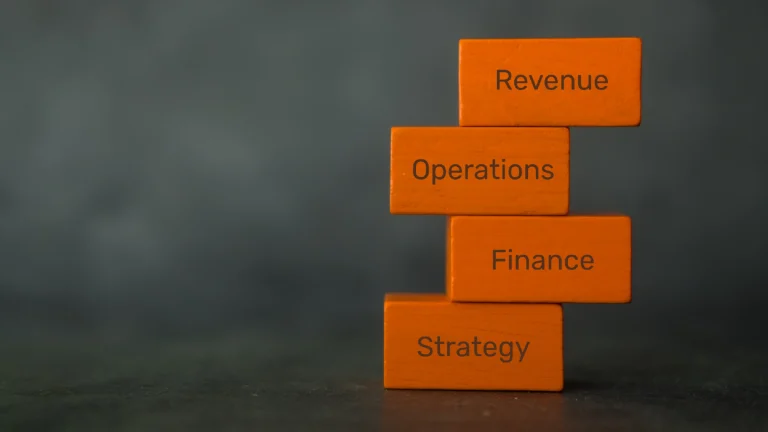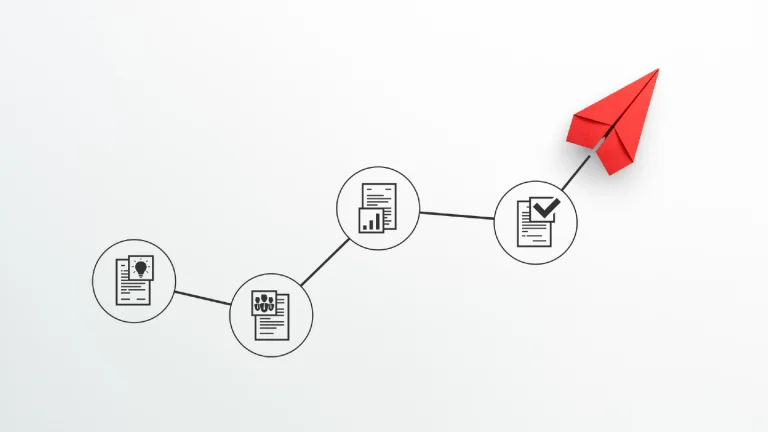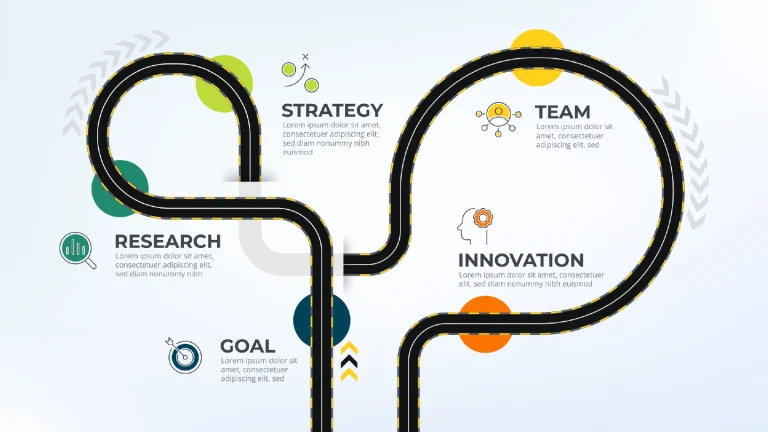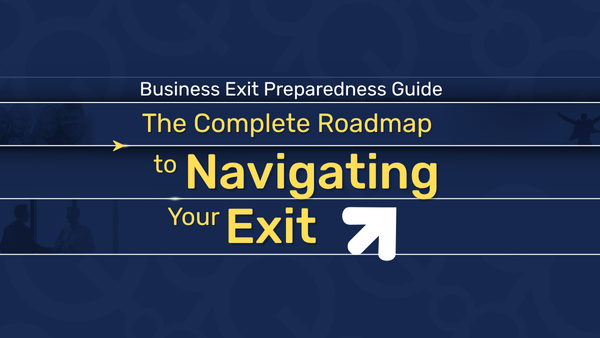The Exit Nightmare Every Business Owner Fears

Your business is probably the biggest thing you’ll ever sell. For most owners, it represents 70-90% of their net worth. Unlike diversified investment portfolios, you can’t spread this risk across multiple assets. It’s all or nothing, and the timing is largely out of your control—unless you’ve prepared a contingency exit strategy that accounts for disruption and uncertainty.
That concentration risk keeps smart business owners awake at night. History shows that economic disruptions consistently derail planned exits, forcing owners to either accept heavily discounted valuations or postpone sales indefinitely while watching years of value creation evaporate.
The fear isn’t irrational; it’s mathematical. When your entire financial future depends on a single transaction that must occur within a narrow window of your choosing, any external shock becomes an existential threat.
Recent crises have validated these concerns repeatedly. The 2020 pandemic froze M&A markets as buyers retreated amid uncertainty. The 2008 financial crisis followed the same pattern, with acquisition activity plummeting and valuations compressing across industries. Even smaller market disruptions can delay deals for months or years.
Each crisis teaches the same lesson: market conditions change faster than exit timelines, and traditional exit planning assumes a stability that rarely exists.
The math is unforgiving: When crisis hits, traditional exit planning becomes a liability rather than an asset.
The Crisis Vulnerability That's Killing Exit Values

Most business owners plan exits around optimal conditions: strong revenue growth, stable markets, and abundant buyer appetite. But this approach contains a fatal flaw – it ignores the reality that crises are the rule, not the exception.
The Hidden Vulnerabilities Destroying Contingency Exit Opportunities
The Revenue Concentration Time Bomb Businesses dependent on a few large customers or single revenue streams become instantly unattractive when uncertainty hits. Buyers avoid concentration risk during volatile periods, often walking away from deals that seemed certain just months before.
The Operational Fragility Trap Companies with rigid cost structures and inflexible operations cannot adapt quickly enough when markets shift. What buyers see as “efficient” in good times becomes “fragile” during stress, dramatically reducing acquisition interest.
The Market Timing Mirage The belief that you can time your contingency exit perfectly around market peaks ignores the unpredictable nature of economic cycles. Companies waiting for “optimal” conditions often find themselves trapped when those conditions evaporate overnight.
The Single-Scenario Planning Fallacy Most contingency exit strategies assume one future: continued growth in stable markets. But sophisticated buyers know that resilience through uncertainty is far more valuable than optimization for specific scenarios.
The Real Cost of Crisis Vulnerability
Research shows that during the 2008 financial crisis and 2020 pandemic, companies fell into distinct categories:
The Casualties (60-70%): Businesses that saw values plummet by 40-60% and became distressed sales or complete write-offs.
The Survivors (20-30%): Companies that maintained operations but lost years of value creation and contingency exit momentum.
The Thrivers (9-10%): Businesses that not only survived but emerged stronger, commanding premium valuations and attracting strategic buyers.
The difference between these groups wasn’t luck or industry. It was an intentional design for resilience.
The $800 Million Crisis-Proof Exit: What Resilient Companies Do Differently

While most businesses struggled during the 2008-2009 recession, some exits not only proceeded but commanded premium valuations. PayPal’s $800 million acquisition of Venmo in 2013 (for a company launched during the recession) illustrates what crisis-resistant businesses do differently.
The Venmo Resilience Model
Counter-Cyclical Positioning: While traditional financial services contracted, Venmo addressed emerging needs for digital financial solutions that became more important during crisis.
Minimal Fixed Costs: The platform model required limited physical infrastructure, allowing operations to scale efficiently regardless of economic conditions.
Essential Service Evolution: Digital payments transformed from convenience to necessity as behaviors shifted during economic stress.
Future-Ready Technology: Mobile-first design positioned the company for post-crisis growth trends.
Building Anti-Fragile Business Architecture

Research by McKinsey following 4,700 companies through three recessions identified that resilient companies outperformed non-resilients by 150% over ten years, delivering essentially double the returns of the S&P 500. These companies shared specific structural characteristics.
The Four Pillars of Crisis-Resistant Business Design
1. Revenue Resilience Architecture Companies with recession-resistant characteristics continue performing well during economic duress. Factors contributing to this phenomenon include serving necessities and addressing fundamental human needs that can’t be postponed.
Essential Services Positioning: Healthcare, food, utilities, and basic maintenance services maintain demand regardless of economic conditions.
Counter-Cyclical Elements: Some services become more valuable during crisis – like financial planning, business consulting, and efficiency solutions.
Subscription Revenue Models: Recurring revenue provides predictability that buyers value enormously during uncertain periods.
2. Operational Flexibility Engineering Harvard Business Review research shows companies with strongest post-recession performance combined cost reductions with diversification and future-forward investments.
Variable Cost Structures: Ability to scale operations up or down quickly without destroying core capabilities.
Multi-Channel Distribution: Reducing dependence on single sales channels or customer access points.
Cross-Trained Workforce: Teams capable of performing multiple functions maintain productivity during disruptions.
3. Financial Fortress Construction Crisis-resistant businesses maintain financial structures that provide options rather than constraints during stress periods
Cash Reserve Requirements: 12-18 months of operating expenses in readily accessible funds.
Diversified Revenue Streams: Multiple income sources that respond differently to economic pressures.
Conservative Debt Structures: Borrowing levels that remain manageable even with 40-50% revenue declines.
4. Strategic Agility Systems Business-model innovation was the most important strategic lever during COVID-19 crisis, with 75% of successful companies reporting such initiatives.
Scenario Planning Capabilities: Regular stress-testing of business models under various crisis conditions.
Rapid Decision-Making Processes: Ability to implement strategic changes quickly as conditions evolve.
Innovation Pipelines: Continuous development of new solutions that can be accelerated during crisis.
Industries That Become More Attractive During Crisis

Technology and Digital Services
Technology support, including cybersecurity and IT services, is now considered recession-proof as demand for technology-related services continues growing. Companies facilitating digital transformation often see accelerated adoption during crisis.
Success Example: Food delivery companies saw such growth during COVID-19 that DoorDash filed for its IPO in December 2020, and Instacart raised over $200 million in capital.
Essential Consumer Services
Industries serving markets where demand stays consistent even when spending tightens demonstrate superior resilience.
Success Example: Walmart outperformed during both 2008 and 2020 recessions, with impressive revenue growth across all segments as consumers sought affordable alternatives.
Healthcare and Wellness
Demand for healthcare services often increases during economic downturns when people become more conscious of health and wellness needs.
Success Example: Telemedicine and digital health platforms saw explosive growth during COVID-19, with many achieving 10-20x user growth in months.
Home and Business Maintenance
Regular maintenance is viewed as wise investment during uncertain times, making these services recession-resistant.
Success Example: Home Depot outperformed the S&P 500 by 23.9% in 2008 and 5.3% in 2020, benefiting from increased home improvement activity during lockdowns.
Building Your Crisis-Resistant Contingency Exit Strategy

Phase 1: Vulnerability Assessment and Foundation Building (0-6 Months)
Financial Architecture Review:
- Analyze revenue concentration and diversification opportunities
- Evaluate cost structure flexibility and variable expense ratios
- Assess cash reserves and credit facility adequacy
- Review debt structures and covenant requirements
Operational Resilience Audit:
- Test business continuity plans and remote operation capabilities
- Evaluate supply chain vulnerabilities and backup options
- Assess workforce cross-training and skill diversification
- Review technology infrastructure and digital capabilities
Market Position Analysis:
- Identify recession-resistant aspects of your business
- Evaluate customer segments and their crisis vulnerability
- Assess competitive positioning during stress periods
- Analyze market share opportunities during downturns
Phase 2: Resilience Infrastructure Development (6-18 Months)
Revenue Diversification Implementation:
- Develop subscription or recurring revenue components
- Create counter-cyclical service offerings
- Expand into recession-resistant customer segments
- Build multiple distribution channels and sales methods
Operational Flexibility Construction:
- Implement variable cost structures and scalable processes
- Cross-train workforce for multiple functions and roles
- Develop remote work and distributed operation capabilities
- Create supplier diversification and backup systems
Financial Fortress Building:
- Accumulate cash reserves equal to 12-18 months expenses
- Establish credit facilities available during stress periods
- Restructure debt with favorable covenants and terms
- Implement rigorous cash flow management systems
Phase 3: Anti-Fragile Positioning (18-36 Months)
Crisis Opportunity Development:
- Build capabilities to acquire distressed competitors
- Develop services that become more valuable during crisis
- Create innovation pipelines addressing post-crisis trends
- Establish strategic partnerships for mutual crisis support
Exit Readiness Optimization:
- Position business for premium valuations from crisis-conscious buyers
- Develop multiple exit scenarios under different market conditions
- Build relationships with buyers seeking recession-resistant assets
- Create documentation proving crisis resilience and adaptability
Common Resilience Mistakes That Destroy Contingency Exit Value

The Over-Optimization Trap
Cutting too deeply during crisis can eliminate capabilities that made the business attractive, reducing long-term contingency exit value for short-term survival.
Solution: Maintain investment in core differentiators while optimizing non-essential expenses.
The Single-Point-of-Failure Design
Companies dependent on single customers, suppliers, or revenue sources become highly vulnerable and unattractive to sophisticated buyers.
Solution: Diversify all critical business dependencies and create backup systems.
The Technology Lag Disaster
Businesses postponing digital transformation during crisis often find themselves obsolete when recovery begins.
Solution: Accelerate technology adoption during crisis periods when competitors are cutting back.
The Culture Casualty Syndrome
Organizations sacrificing culture and talent during downturns lose competitive advantages that drove success.
Solution: Invest in cultural resilience and talent retention during stress periods.
Your Crisis-Resilience Implementation Roadmap

Immediate Actions (Next 30 Days):
- Cash Position Analysis: Calculate current cash runway and identify additional sources
- Revenue Concentration Assessment: Analyze customer and revenue stream dependencies
- Cost Structure Review: Identify fixed vs. variable expenses and optimization opportunities
- Crisis Scenario Planning: Model business performance under 25%, 50%, and 75% revenue declines
90-Day Strategic Implementation:
- Revenue Diversification: Launch initiatives to reduce concentration risk
- Operational Flexibility: Implement scalable processes and cross-training programs
- Technology Infrastructure: Accelerate digital transformation and remote capabilities
- Financial Optimization: Secure credit facilities and optimize cash management
Annual Resilience Building:
- Market Position Strengthening: Build dominance in recession-resistant segments
- Anti-Fragile Capabilities: Develop systems that benefit from volatility
- Strategic Partnerships: Create relationships providing mutual crisis support
- Exit Positioning: Establish relationships with buyers valuing crisis resilience
Assessment Questions for Crisis Readiness

Financial Resilience Test:
- Can your business operate for 12+ months with 50% revenue decline?
- Do you have multiple revenue streams responding differently to economic stress?
- Are your debt obligations manageable with significantly reduced cash flow?
Operational Flexibility Evaluation:
- Can you maintain core operations with 50% of current workforce?
- Do you have backup suppliers and distribution channels?
- Can your business model adapt quickly to changing market conditions?
Strategic Positioning Assessment:
- Would demand for your products/services increase or decrease during crisis?
- Can you identify acquisition opportunities that emerge during downturns?
- Do you serve needs that become more important during stress periods?
Exit Readiness Review:
- Have you identified buyers specifically seeking crisis-resistant businesses?
- Can you demonstrate resilience through previous crisis performance?
- Would your business be more or less attractive during market uncertainty?
The Future Belongs to Anti-Fragile Businesses

At 9Q Exit, we specialize in transforming businesses into anti-fragile enterprises that attract premium valuations regardless of market conditions. Our team combines deep expertise in crisis-resistant business architecture with extensive networks of buyers specifically seeking resilient companies. Contact us to learn how to turn market uncertainty into your greatest competitive advantage and exit opportunity.
The companies commanding premium contingency exit valuations in the next decade won’t be those that merely survived the last crisis, but those architected to thrive through any crisis. Research shows that 9% of companies emerge from recession stronger than ever, and these businesses consistently demonstrate superior long-term performance.
Crisis resilience isn’t about survival – it’s about transformation. In a world of increasing volatility, the ability to benefit from uncertainty has become the ultimate competitive advantage and the most valuable trait buyers seek.
Your contingency exit strategy should be your primary exit strategy, because in an uncertain world, anti-fragility is the new competitive moat. The businesses that master this architecture don’t just survive crises; they use volatility as fuel for exponential growth and premium exits.
Crisis will come. The question is whether your business will be among the few that buyers fight to acquire when uncertainty strikes.







